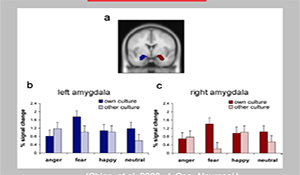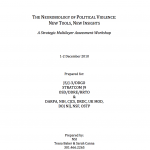Neurobiology Insights on Political Violence

Proceedings from the Neurobiology of Political Violence: New Tools, New Insights Workshop.
Author | Editor: Canna, S. (NSI, Inc).
The Neurobiology of Political Violence: New Tools, New Techniques workshop hosted by the National Institutes of Health (NIH), United States Strategic Command (STRATCOM), the Joint Staff, and the Strategic Multilayer Assessment Office (OSD) brought together nearly 80 representatives of government, academia, and industry in Bethesda, MD from 1-2 December 2010. The workshop facilitated a broad discussion of the current state of the art within the related fields of neuroscience, neurobiology, and social psychology as it relates to deterring political violence. While most panelists emphasized the prematurity of applying current research to real world problems within the national security and homeland defense space, they all agreed that the tools of neuroscience and related fields would serve to better inform current deterrence and messaging strategies.
The workshop was organized as a series of panel discussions and individual discussion sessions. This executive summary is organized by session for ease of reading and use.
Opening Remarks
Ms. Abigail Chapman, Senior Research Scientist at NSI, welcomed the workshop participants to the Neurobiology of Political Violence workshop with a discussion on the design and intent of the workshop. She noted that researchers have always been fascinated by the complexities of the human brain and, in particular, investigating the relationship between mind and body. In order to develop a deeper understanding of individuals who are involved in violent extremist activities, it is essential to use a multi-method, multi-disciplinary approach that specifically focuses on the complex relationships between attitude and intent formation and, ultimately, behavior manifestation. Thus, panelists were purposely selected from diverse disciplines and backgrounds.
Although the conference is entitled, The Neurobiology of Political Violence: New Tools, New Insights, the Steering Committee sought to encourage open discussion of pertinent findings and to allow for the cross-pollination of ideas, identification of areas for collaboration, and topics upon which other findings can inform and augment the dialogue. Additionally, she sought to emphasize that the conference served as an invaluable launching point for previously unknown research and proliferation of ideas and concepts beyond their initially intended audience.
Introductory Briefings
Ms. Abigail Chapman moderated the first session, which focused on highlighting the connection between basic research and the topics of counter-terrorism, radicalization, violent extremism, and deterrence. The briefers set the stage for the workshop with a discussion of the historical and potential future application of research findings from the fields of neurobiology, social psychology, and linguistics to further our understanding of political violence. This first session (taken together with the read-ahead material) provided conference participants with sufficient background to not only understand the subsequent research presented, but also turn a critical eye towards understanding the potential implications and limitations of this area of research.
Panel Discussion: Basics of the Science
The first panel discussion on the basics of science was moderated by LtCol William Casebeer, DARPA, with a specific focus on understanding behavior and attitude formation from the disciplines of social psychology, cognitive neuroscience, and political science. The panelists spoke on a variety of related topics, yet all agreed that it is critical to have a common set of definitions when discussing violence across disciplines to ensure that the same concept is being addressed. Although the field of neuroscience is exciting, it is essential for people to understand that the research is at a relatively nascent stage with some topical areas more developed than others./
Panel Discussion: Research I
The first research panel focused on a discussion on the psychological and neurobiological mechanisms underlying violent behavior and decision-making processes. The research panel discussion was moderated by Dr. Tom Feucht, a science advisor to the National Institute of Justice (NIJ) at the US Department of Justice (DOJ). Panelists discussed the ways in which research findings from the fields of social psychology and neuroscience can inform and enrich our understanding of how political attitudes are formed and how and when people practice deception. Additionally, panelists discussed the various ways in which researchers are able to use advanced technologies, such as simulated environments and functional magnetic resonance imaging, to understand how decisions are made and, more specifically, what components of a message are the most persuasive and “sticky” to a target audience. This discussion culminated in the agreement that further research is required in this area, but that there is great benefit to be gained from pairing research targeted at understanding attitude formation and decision-making processes with the tools employed by neuroscientists and neurobiologists.
Panel Discussion: Research II
The second research panel focused on aggression, fear, and trust with a specific emphasis on fear’s impact on decision making and violent behavior. The panel was moderated by Dr. Amber Story of the National Science Foundation. The panelists discussed several topics, including the psychologically motivating factors of terrorism inherent in the Terror Management Theory–a theory that is founded upon the basic principle that human beings are motivated to adopt and police a cultural belief system in order to allay their concerns over their own mortality. Sets of sacred values underpin strong belief systems; such values include those beliefs that an individual is unlikely to barter away or trade no matter how enticing the offer is. While further research is required, sacred values may prove a pathway towards better understanding the deep underlying motivations behind certain acts of political violence and identifying values that are less resistant to change such that they may be used to alter an individual’s belief system and/or motivational schema. The panel also discussed the interactive effect of the environment, developmental process, and genetic expression reflected in the brain. Additionally, the panel discussed the advancement of science in regards to exploring the association between genes and the outward manifestation of behaviors relevant to actions of political violence.
Panel Discussion: Research III
The final panel, moderated by Dr. Debra Babcock, NIH, explored research regarding the impact of emotions and stress on decision making and decisions to engage in violent behavior. Several panelists discussed the ways in which emotion or emotional responses to negatively-perceived stimuli interact with an individual’s decision-making process, attitude formation, and subsequent behavior. Emotion plays a significant role in an individual’s decision to engage in violent behavior; for instance, it was mentioned that violence is an emotional act between groups that can be influenced through genetics, environment, narratives, and perceived behaviors of others.
Building upon the notion that emotions can be modified and transformed through stories or narratives, it may be possible that once the right trigger mechanisms within a story are identified and altered, emotion, or at least the cognitive or behavioral manifestation of the emotion, may prove to be malleable. Additionally, several panelists noted that it may be possible to identify situations in which actions of political violence are likely to occur through observing identified tendencies. For example, a historical examination of state communications preceding international acts of violence show a diminished amount of cognitive complexity in the time immediately prior to the action of the aggressor, but not for the attacked. It was hypothesized that this occurs because the aggressor has already committed to a decision, is no longer stressed or anxious about the outcome, and is engaging in heuristic (vs. systematic) processing of information. Thus, by studying the cognitive complexity of a state leader’s communication, it may be possible to identify times in which they are seemingly engaging in heuristic processing of information and, thus, more likely to already have a set course of action in mind. Additionally, other research has shown that there may be universal facial expressions for the identified emotions of contempt and disgust that are generally displayed on the faces of individuals immediately prior to engaging in acts of violence. If future research builds upon the findings, then this may prove to be useful research for identifying critical intervention moments.
Putting It All Together–What Does This All Mean?
The concluding panel of the conference sought to answer the question “so what?” in an effort to integrate the research discussions and provide the policy and decision makers in attendance with critical takeaways. The final session was moderated by Dr. Diane DiEuliis, Assistant Director for Life Sciences in the President’s Office of Science and Technology Policy (OSTP). Dr. DiEuliis mentioned that this is an area of pressing national security need and, if the government begins to sponsor more research in the neurosciences and the social, behavioral, and cultural fields, there will be tremendous, beneficial spillover effects. The field of cognitive neuroscience is not only pioneering, but when paired with social science, it will increasingly inform the United States Government’s (USG) understanding of international relations and actions of political violence. It should be noted that it is critical to recognize that, although promising, researchers in the field of cognitive neuroscience must continue to conduct and build upon basic research; additionally, they must open the discourse to other research domains in order to obtain the most comprehensive understanding of this topical area.
Dr. DiEuliis and the panel applauded the research discussed during the workshop and all agreed that the cross-pollination of ideas and research findings will prove beneficial in the long run, but that the neuroscience research is still relatively basic, and there remain areas requiring significant exploration. For example, further research is required to determine whether it may be possible to identify the antecedents of political violence and terrorism prior to an act of violence occurring. Likewise, it is important to determine whether there are specific markers of political violence relative to other, more generic acts of violence. Attendees at the workshop and individuals interested in understanding political violence, motivations of and methods to deter, should feel confident that there exists a comprehensive and diverse set of research findings that can help inform and deepen the understanding of political violence. When taken together, it may be possible to predict acts of political violence from afar (e.g., using facial affective recognition systems, analysis of cognitive complexity of leaders, etc.), to understand a population’s proclivity to trust (accomplished through research on the socio-economic impact on certain brain chemicals in populations) and, finally, to craft targeted deterrence messages using key terms, images, and mode using neuromarketing techniques.

Comments